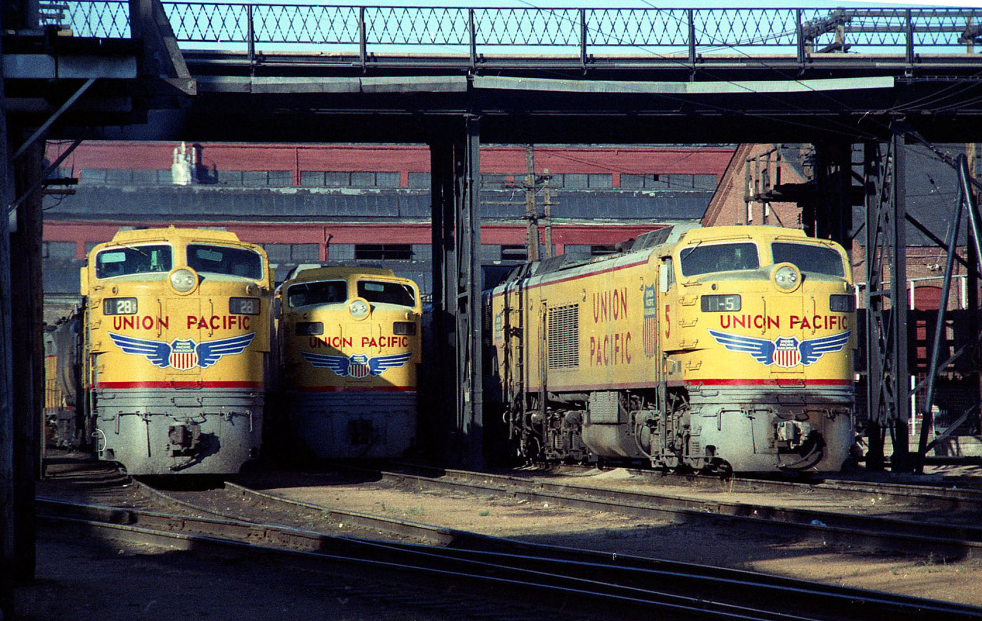| It Happened in . . . November |

|
| New: 1 November 2024 |
Alan M. Miller photo / J. David Ingles collection |
| American Locomotive Company |
Followers of the Lehigh Valley were treated to an early Christmas when Alco
delivered nine Century 628s in late November 1965. Originaly build for the Monon in March 1964, the Alco
six-motors were not roadbed friendly, causing the Monon to swap them for brand new four-axle 2000-hp
Centuries. Rebuilt and attired in a snazzy white and black paint scheme, the newly arrrived 2800-hp Alcos
quickly got the name "Snowbirds." Carryin road numbers 633-641, the snowbirds drew all kinds of assignments
and proved to be well suited for the Valleys up and down profile. |
| Baldwin Locomotive Works |
During the Steam Age, locomotive production was all about customization, and building to the
customer's exact needs. The Diesel Era in constrast was more about standardization and speed of delivery -- but
not always. Several railroads still had special needs that had to be met, and Baldwin was more adept perhaps at
addressing those special requirement than any other diesel manufacturer. From BLW's Eddystone plant, there came
single-cab, double-cab, four-axle, six-axle, A-units and B-units, and even 12-axle locomotives; owners sometimes
had a choice between supercharged power plants or normally aspirated engines. C&NW's order for a single DR6-2-1000 is
such an example. Delivered in November of 1948, C&NW cab unit 5000A was a six-axle locomotive powered by a single
superchaged six-cylinder 606 engine. The carbody had been designed for a second engine, but it was displaced by a
baggage compartment. The approach gave the railroad greater consist flexibility on secondary trains and lines. |
| Electro-Motive Division |
By the enod of the 3rd Quarter of 2011, GO Transit (Government Owned) reached a major a milestone
by carrying its one-billionth rider since rail operations began 44 years ago. Initially, the commuter agency had only
two rail lines serving Toronto; today it operates seven rail corridors. The public rail service reached out to EMD in
1966 for their first passenger locomotives. The LaGrange builder's response came in the form of eight new GP40TCs
(Toronto Commuter) #600-607. The four-axle units were constructed on SD40 underframes and driven by 16-cylinder,
3000-hp EMD 645 prime movers. A 500-kW generator was installed at the end of an elongated hood to provide train
heat and lighting. The GP40TC's tenure on GO Transit ended in 1988, with them being sold to Amtrak as #192-198.
|
| Fairbanks-Morse & Company |
Performance of the U.S. Navy Submarine fleet during WWII is well documented. The pride of the
"Silent service" were nearly 250 Fleet-type subs; more than half of which were powered by four Fairbanks Morse's 38D
In-line opposed-piston engines. Built in nine and ten-cylinder versions, the 1600-hp 38Ds proved durable and highly reliable.
However, by mid-1946,the production of future 38Ds was in serious jeopardy, as plans for a new atomic-powered sub were
already on the drawing board. Consequently, Fairbanks Morse began marketing to the railroad industry. The first couple
of orders were for 1000-hp yard engines, they came from the Milwaukee Road and Chicago & North Western. C&NW would
eventually own 84 FM-built locomotives; the first of them was H10-44 #1036 delivered in November 1946. |
| General Electric |
Union Pacific's "love affair" with turbine-powered locomotives was far from a passing fancy. The big
machines polished UP rails from Seattle to Council Bluffs and Omaha to Los Angeles. The first turbines to arrive were
two steam-driven passenger units built in 1938. They were followed ten years later by the first of 26 4500-horsepower gas
turbines built by General Electric. The success of the early turbines led UP to purchase thiry new 8500-hp gas turbine
locomotives; these GE-built units began arriving in 1958. About the same time, UP had been collaborating with the Erie
manufacturer on the development of an epxerimental goal-powered turbine locomotive. Testing of the 9000-hp locomotive
began in very early November 1962 and concluded nearly 18 months later. The experiment consisted of #80, a control unit
(ex-UP Alco 2000-hp PA-1 #607) and #80B, a 7000-hp turbine unit built from ex-Great Nortern electric 5018). The distinctive
combo hauled their last train in May 1964. |
| Lima-Hamilton Corporation |
Lima-Hamilton was the last of the major steam locomotive builders to enter into diesel locomotive
production; its first diesel offering was a 1000-hp, standard end-cab switcher. Built in mid 1949, the model was powered by a
turbo-charged eight cylinder T89SA power plant that produced 1000 horsepower. Cincinnati Union Depot, which was looking to
dieselize its terminal operations, opted for the six-cylinder version of the L-H switcher that produced 750 horsepower. The CUT
ordered was for six units, with the first two (#20 and 21) arriving on November 23 1949, and the last (#25) being delivered in
June 1951. No other examples of this locomotive model were built by L-H.
|
| Attention: Your comments and ideas are always welcomed. Thanks! |
Back to Main Menu
